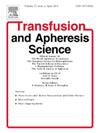The impact of anticoagulant used for peripheral blood collection on NK cell yield, function, and proliferation
IF 1.2
4区 医学
Q4 HEMATOLOGY
引用次数: 0
Abstract
Natural killer (NK) cells are under investigation for cellular immunotherapy of cancer, infectious diseases, and autoimmunity. The collection of autologous or allogeneic starting material for the expansion of NK cells - whether whole blood, cord blood, or leukocyte apheresis - requires the use of anticoagulants. Heparin and acid citrate dextrose A (ACD-A) are most commonly used for collection, but their impact on NK cells has not been clearly described. As functional impairment has been described for irreversible calcium chelation with EDTA, we hypothesized that prolonged calcium chelation by ACD-A might also have an adverse impact on NK cell health, particularly with prolonged exposure. To test this hypothesis, peripheral blood was collected as paired samples in heparin and in ACD-A, stored for 24 h at room temperature, and then tested for viable NK cell yield and proliferative capacity for 2 weeks under ex vivo expansion. Both conditions yielded similar viability and T/NK cell content after initial isolation. However, compared to ACD-A-treated blood, heparin-treated blood provided a mean 23 % higher initial yield of NK cells (p = 0.03) and a non-significant trend toward greater fold expansion, which resulted in 60 % higher overall yield after expansion (p = 0.048). These data suggest that both ACD-A and heparin can be used for NK cell collection, but that heparin may be the preferred anticoagulant if there is an expected delay in the product processing such as a pause for overnight testing or shipping. Process development for cellular therapeutics should assess the impact of anticoagulant used for cell collection.
用于外周血采集的抗凝剂对NK细胞产量、功能和增殖的影响
自然杀伤(NK)细胞在癌症、感染性疾病和自身免疫的细胞免疫治疗中的应用正在研究之中。无论是全血、脐带血还是白细胞分离,收集用于NK细胞扩增的自体或异体起始材料都需要使用抗凝剂。肝素和柠檬酸葡萄糖A (ACD-A)是最常用的收集方法,但它们对NK细胞的影响尚未得到明确描述。由于与EDTA不可逆的钙螯合作用已被描述为功能损伤,我们假设ACD-A的长期钙螯合作用也可能对NK细胞健康产生不利影响,特别是长时间暴露于ACD-A。为了验证这一假设,将外周血作为配对样本收集在肝素和ACD-A中,在室温下保存24 h,然后在离体扩增下测试2周的活NK细胞产量和增殖能力。初始分离后,两种条件均获得相似的活力和T/NK细胞含量。然而,与acd - a处理的血液相比,肝素处理的血液NK细胞的初始产量平均高出23 % (p = 0.03),并且有不显著的倍数扩增趋势,这导致扩增后的总产量高出60 % (p = 0.048)。这些数据表明,ACD-A和肝素都可以用于NK细胞的收集,但如果在产品加工过程中有预期的延迟,如暂停过夜测试或运输,肝素可能是首选的抗凝剂。细胞治疗的工艺发展应评估用于细胞收集的抗凝剂的影响。
本文章由计算机程序翻译,如有差异,请以英文原文为准。
求助全文
约1分钟内获得全文
求助全文
来源期刊
CiteScore
3.60
自引率
5.30%
发文量
181
审稿时长
42 days
期刊介绍:
Transfusion and Apheresis Science brings comprehensive and up-to-date information to physicians and health care professionals involved in the rapidly changing fields of transfusion medicine, hemostasis and apheresis. The journal presents original articles relating to scientific and clinical studies in the areas of immunohematology, transfusion practice, bleeding and thrombotic disorders and both therapeutic and donor apheresis including hematopoietic stem cells. Topics covered include the collection and processing of blood, compatibility testing and guidelines for the use of blood products, as well as screening for and transmission of blood-borne diseases. All areas of apheresis - therapeutic and collection - are also addressed. We would like to specifically encourage allied health professionals in this area to submit manuscripts that relate to improved patient and donor care, technical aspects and educational issues.
Transfusion and Apheresis Science features a "Theme" section which includes, in each issue, a group of papers designed to review a specific topic of current importance in transfusion and hemostasis for the discussion of topical issues specific to apheresis and focuses on the operators'' viewpoint. Another section is "What''s Happening" which provides informal reporting of activities in the field. In addition, brief case reports and Letters to the Editor, as well as reviews of meetings and events of general interest, and a listing of recent patents make the journal a complete source of information for practitioners of transfusion, hemostasis and apheresis science. Immediate dissemination of important information is ensured by the commitment of Transfusion and Apheresis Science to rapid publication of both symposia and submitted papers.

 求助内容:
求助内容: 应助结果提醒方式:
应助结果提醒方式:


